enclosed
wood and acrylic panels
The ancient Chinese partition caught my attention as a subject due to its multifunctional use as a decorative art piece with beautiful washes and fabric designs as well as its practical (and architectural) use of dividing interior space within a room. These partitions are also present within significant cultural contexts such as tea ceremonies or the rooms of important figures. Another part of ancient Chinese culture that I included was the constructional practice of not using any adhesives and solely relying on advanced joinery techniques. Here, I utilized mortise-and-tenon joints to stay true to traditional practice, and the acrylic panels also serve a structural purpose of locking the wooden lattice into place (almost like an adhesive).
As for stained glass windows, especially within Gothic architecture, stained glass windows served as a way to create an ethereal and transformative space within the interior of a church. These stained glass windows often appear with the motif of a triptych that symbolizes The Holy Trinity. Furthermore, the advanced technology of Gothic architecture with pointed arches allowed larger and grander stained glass windows that ultimately brought more light into the interior space.
Exploring ways to synthesize aspects of European and East Asian art, I decided to take elements from Christian stained glass triptychs and the ancient Chinese partition. In addition, I also strived to incorporate a twist to the functionality of what we would consider a partition.
While working on this project, I questioned what it meant to takeaway the practical use of a partition by having it transparent and see through with a pattern that reference fabric or cloth—another material of partitions. Also, how does this sculpture interact with light through its meaning and physicality?

